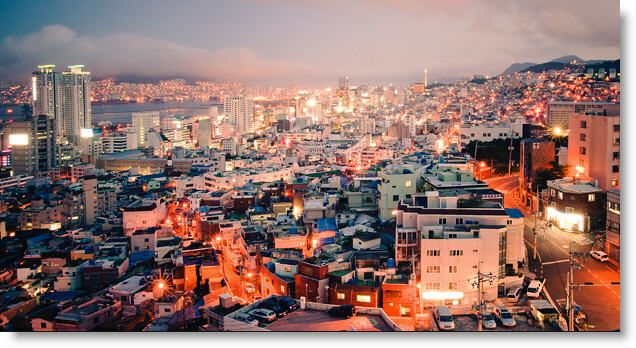By Nicos Komninos — The Mark News —
As globalization slows and the world’s urban populations increase, the integration of smart technology into city planning will help support economic growth and ensure the world’s cities remain livable and sustainable.

The UN report World Urbanization Prospects indicates the continuing growth of urban populations, with an expected increase of 2.5 billion people to the world’s urban population by 2050, and a total of 66 percent of the world’s population living in cities by the same year. It also highlights that challenges for sustainable development will be increasingly concentrated in cities, particularly in the lower-middle-income countries where urbanization is fastest. Such enormous growth trends imply that urban development is both an opportunity and a threat. During the recent launch of Smart City projects in India, PM Narendra Modi said, “It is now our responsibility to provide strength to cities so that it can mitigate the maximum poverty, in the shortest time, and add new avenues for development.” In this new context, city planning should radically disrupt the patterns of consumption and use of space and resources of the 20th century and seek more efficient models of city functioning. Urban policies, on the other hand, should provide access to health care, education, public transportation, housing, electricity, water and sanitation, making optimum use of available resources.
The promise of smart cities, as an urban development and planning model for the 21st century, is that they can address such complex problems, and implement more efficient use of resources and more intelligent systems of decision-making and innovation. Smart cities offer hundreds of solutions that enable urban communities to improve the economy of cities, infrastructures and utilities, the environment, and living conditions.
Smart cities work by, introducing a series of innovations into the urban system which are deployed on three innovation circuits. In the first circuit, the digital infrastructure of cities is created; this is composed of broadband networks, access devices, cloud infrastructure, software applications and various types of data coming from citizens and organizations, the public administration, social media and sensors. This digital layer is formed gradually by the continuous enrichment of urban informatics, operating systems and software applications.
In the second circuit, the urban innovation system is enriched by digital assistants and virtual collaboration, such as online planning and city management, crowdfunding platforms and location analytics, which close gaps in capabilities of institutions for innovation. In the third innovation circuit, the behaviour of users, citizens and organizations is improved, because the digital infrastructure and platforms of cities enable more informed and efficient individual choices. These three innovation circuits determine the efficiency of smart cities in the fields of growth, sustainability, utility management and governance. Let’s have a quick horizon scan on smart cities efficiency.
In the field of growth, the global economic outlook over the past five years indicates a slowing down of globalization, but also the emergence of new drivers and technologies that sustain economic growth for the years to come. A key new driver for growth is the digitally transformed business environment and digital markets, which introduce “digital disruptions” to business practices and business models. The organisation of companies changes because of affordable hyper-connectivity, web-based collaboration and ubiquitous access over broadband networks. Smart cities offer the environment for this type of business disruption. They provide digital platforms and commons, which other businesses can use as externalities to define their own value proposition. Such platform-based business models enable the association of smaller service providers and disrupt one sector of the economy after another. Airbnb and Uber are well known cases of such platforms of service aggregation, turning consumers into producers and eliminating intermediaries.
A good example of smart city strategy aiming at the revitalisation of the city economy was the iN2015 (Intelligent Nation 2015), a masterplan for turning Singapore into an intelligent island. Singapore plans to be the world’s first in harnessing infocomm to add value to the economy and society, aiming for a two-fold increase in the value of the infocomm industry to $20 billion, and a three-fold increase in infocomm export revenue to $45 billion. The plan identified the most important sectors of economic activity of the city, from logistics and manufacturing to media, financial services and health care, and designed digital infrastructure specific to each industry, with a goal of creating up to 80,000 additional jobs. Digital platforms per sector introduced a combined process of innovation (the capacity to create new products or new ways of doing something), integration (the ability to harness resources and capabilities across diverse organizations and geographies) and internationalization (integration into the globalized economy).
In the field of environment, smart city solutions contribute to environmental sustainability through energy optimization and conservation. For instance, sensor-based solutions and smart grids can reduce energy consumption and peak demand. The initiative “Future City Glasgow” is developing street lighting networks to respond to incidences of crime while saving on energy. Sensors are installed in lights so that they can be dimmed at times of low risk and brightened when sensors detect noises, using the city’s lights as safely and efficiently as possible.
Dematerialization is another route to environmental sustainability, as smart cities enable the substitution of digital space for material space. Urban practices taking place in digital environments reduce the need for space, infrastructure and mobility. Most disruptive, however, is the contribution of smart cities to sustainability through the rise of “zero culture.” Zero-carbon cities, zero-fatal accident cities and zero-waste cities are visions for complex cyber, physical and institutional environments that enable radical and effective solutions to urban challenges. Another very good demonstration of this logic is the “zero vision” initiative, the road safety plan initially developed in cities of Sweden and currently under implementation in New York, which understands traffic crashes as the result of actions that can be prevented through city re-design, digital technology, real-time alert, education, and law enforcement.
Amsterdam Smart City (ASC) is among the best showcases of smart city projects, applications and solutions globally. Initiated in 2009, ASC covers ten domains of city life, with 93 ongoing and completed projects. The overall Climate Programme of the City, in which ASC is a key component, aims to reduce CO2 emissions by 40 percent, with respect to the 1990 baseline, by 2025. ASC aims to contribute to these targets by reducing energy use by at least 14 percent and reducing CO2 emissions by an equal amount. Residential projects have focused on smart meters, providing readable displays that enable users to be more aware of energy consumption, and even make it possible to see energy usage per appliance. The ITO Tower pilot, a project to obtain insights by testing energy saving in a large multi-tenant office building using smart-building technologies eventually saw energy consumption fall by 18 percent. Overall, while the first round of ASC projects has had only a limited impact, scaled-up versions projects have much greater potential.
In the ICOS repository, we have gathered about 100 software applications and solutions for smart cities targeting four typical sub-systems of cities: the urban economy, living conditions, city infrastructure/utilities and city governance. Applications offer different functionalities to cities and work under a model of agglomeration and collaboration. However, in a series of applied smart city projects, it became clear that the effectiveness of smart city solutions depends on a kind of “connected intelligence” that sets networks among people, software, and institutions targeted to a well-defined vision or objective. Because of these dense networks of information flow, knowledge sharing and collaboration, smart city development and planning are radically different from traditional city development and planning.
________________________________________________________
 Nicos Komninos is a professor at the Aristotle University of Thessaloniki and director of the Urban and Regional Innovation Research (URENIO). His expertise is on “intelligent cities” and “cyber-physical systems of innovation”. He has coordinated about one hundred projects under the European research and territorial development programmes and has been honoured with the Award for Excellence and Innovation for achievements in competitive research. He has worked as an expert for the European Commission in the development of technology parks, regional innovation strategies and digital growth strategies across many regions of Europe; for UNIDO on innovation in developing countries; and the OECD innovation strategy. He has published extensively on territories of innovation, smart and intelligent cities, including a trilogy on intelligent cities (Routledge 2002; 2008; 2014). He is associate editor of the “Journal of Smart Cities” and member of the editorial board of ten other academic journals.
Nicos Komninos is a professor at the Aristotle University of Thessaloniki and director of the Urban and Regional Innovation Research (URENIO). His expertise is on “intelligent cities” and “cyber-physical systems of innovation”. He has coordinated about one hundred projects under the European research and territorial development programmes and has been honoured with the Award for Excellence and Innovation for achievements in competitive research. He has worked as an expert for the European Commission in the development of technology parks, regional innovation strategies and digital growth strategies across many regions of Europe; for UNIDO on innovation in developing countries; and the OECD innovation strategy. He has published extensively on territories of innovation, smart and intelligent cities, including a trilogy on intelligent cities (Routledge 2002; 2008; 2014). He is associate editor of the “Journal of Smart Cities” and member of the editorial board of ten other academic journals.





